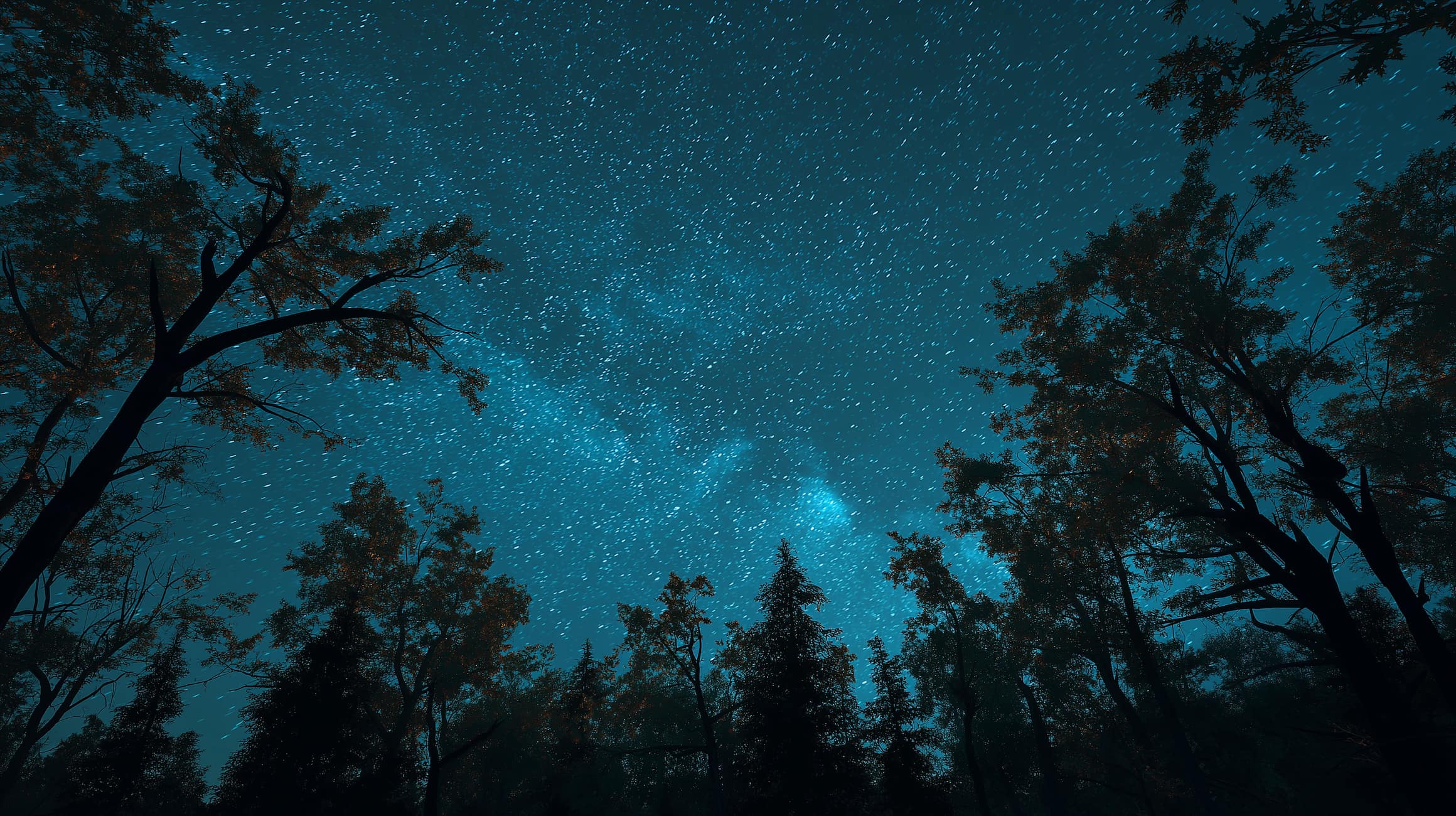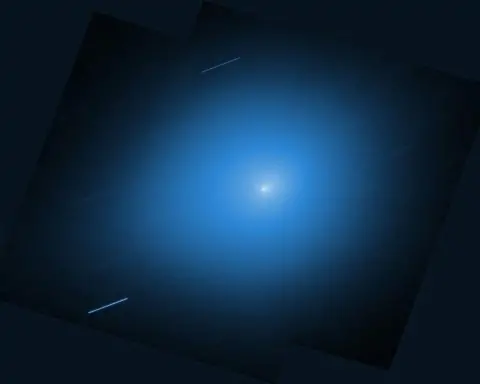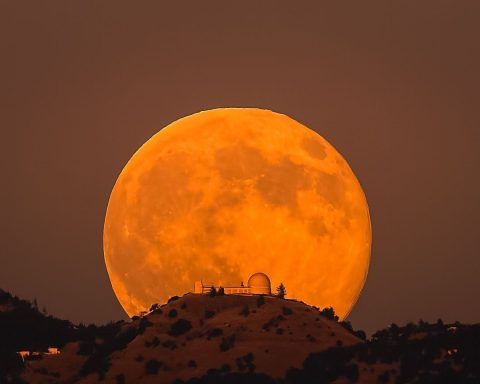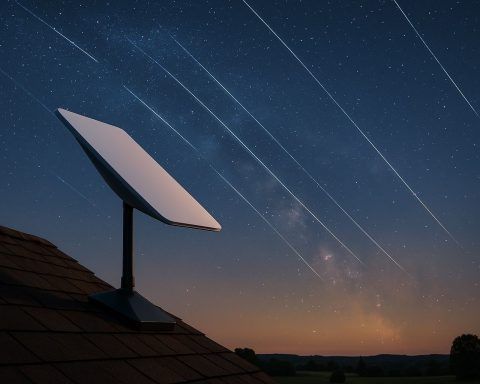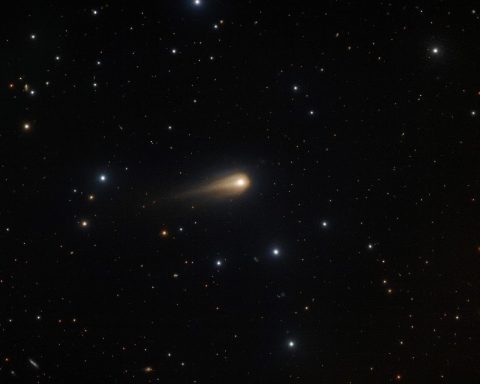Key Facts:
- Global Moonwatch Party (Oct. 4): Saturday is International Observe the Moon Night, with NASA leading 950+ events worldwide to celebrate and observe Earth’s moon [1] [2]. Enthusiasts are hosting moon-gazing parties, both in-person and online, to share views of the lunar surface and spark curiosity about lunar science. NASA’s official site offers an event finder and free observing guides for anyone who wants to join in or host their own mini Moon watch [3].
- “Harvest” Supermoon Lights Up the Sky: The full Moon on October 6 is 2025’s Harvest Moon (the full moon nearest the autumn equinox) and a supermoon, meaning the Moon is near its closest point to Earth. It will appear about 30% brighter and 14% larger than an average full moon [4]. The Moon reaches official fullness on Monday Oct. 6, but will look nearly full all weekend. This is the first supermoon of 2025, and it rises on Oct. 6 close to Saturn in the evening sky [5], adding to the spectacle.
- Moon Meets Saturn on Oct. 5: On Sunday night (Oct. 5), skywatchers get a special treat – the almost-full Moon will pair up with Saturn in a tight conjunction. Around nightfall, look toward the east-southeastern sky: the bright 98%-illuminated Moon will be hanging just a few degrees above Saturn [6] [7]. The ringed planet will appear as a steady, yellow-white “star” immediately below the Moon, making it easy to find even for newcomers [8]. By ~11 PM EDT, the Moon passes about 2° away from Saturn (roughly a thumb’s width at arm’s length) [9]. If you have a telescope, take a peek – Saturn’s rings are currently nearly edge-on (appearing as a thin line) due to Saturn’s orbital tilt this year [10] [11].
- Draconid Meteors vs. Moonlight: The annual Draconid meteor shower is active in early October, with meteors trickling out from October 6–10 and a predicted peak around Oct. 8 [12] [13]. These slow-moving “shooting stars” originate from debris of Comet 21P/Giacobini-Zinner and radiate from the Draco constellation, but it’s a minor shower (typically ~10 meteors per hour at best) [14]. Unfortunately, this year’s Draconids coincide with the brilliant supermoon, whose glare will wash out all but the brightest meteors [15]. Don’t be surprised if you spot few (if any) Draconids – you can “blame the bright supermoon” and look forward to a stronger meteor display later in the month [16].
- Orionids Coming Later (Oct. 21): If moonlight spoils the Draconids, mark your calendar for the Orionid meteor shower in a few weeks. The Orionids – dust from Halley’s Comet – peak on October 21 and are expected to produce about 20 meteors per hour under ideal conditions [17]. Even better, the Orionids’ peak falls on the new Moon night this year [18]. With no moonlight at all, the pre-dawn hours of Oct. 21 should offer excellent dark skies to catch these swift meteors streaking from the Orion constellation [19].
- New Comet SWAN Graces October’s Sky: A newly discovered comet, C/2025 R2 (SWAN), is making its debut in northern skies this month. Comet SWAN was spotted in September via the SOHO spacecraft and has been brightening to around magnitude +7 – just below naked-eye visibility [20]. Throughout early October, it’s slowly climbing in the southwest after sunset (about 10–15° above the horizon by nightfall in the first week) [21]. Under dark, moonless conditions, keen observers with good binoculars can locate SWAN as a faint fuzzy star with a subtle tail [22]. It will make its closest approach to Earth on Oct. 21 (at ~40 million km away) [23]. Some forecasts suggest the comet could hover near magnitude +6 – right at the threshold of naked-eye visibility – in mid-October [24], though the glaring Moon this week will make it effectively impossible to see without optical aid. Note: Despite chatter on social media, comet SWAN will not produce a meteor shower on Oct. 4–6. Astronomers confirm that Earth will miss the comet’s debris trail by about 7 million km – far too great a gap for any “Swan meteors” to hit our atmosphere [25]. In any case, SWAN is a gas-rich (not dusty) comet, so it’s shedding very little material to begin with [26].
- Aurora Alert Fades After Geomagnetic Storm: Earlier this week, skywatchers were treated to an unexpected aurora display: on Oct. 1, a G3 (strong) geomagnetic storm struck, pushing the northern lights as far south as Pennsylvania and New York [27]. NOAA’s Space Weather Prediction Center had issued a G2 storm watch for Oct. 2, and indeed auroras continued that night across many northern U.S. states [28] [29]. However, this geomagnetic unrest is now winding down. Both NOAA and the UK Met Office forecast that Oct. 2 would likely be the last night of significant auroral activity from this solar wind episode, with conditions quieting through the weekend as Earth exits the high-speed solar wind stream [30]. By Saturday and Sunday (Oct. 4–5), no further aurora alerts were in effect – any northern lights sightings would be limited to high latitudes under normal “quiet” conditions. (In short, don’t expect the dazzling auroras to continue into the Oct. 4–5 weekend [31] [32].) For those ever on aurora watch, NOAA’s Aurora Forecast Dashboard provides real-time northern lights visibility predictions and updates on geomagnetic storm indices [33].
- Planets on Parade – Aside from Saturn’s close-up with the Moon, other planets make noteworthy appearances. Jupiter is now rising around midnight and shining high in the predawn hours, unmistakable as the brightest point in the late-night sky [34]. In the early morning before sunrise, look east to find a blazing Venus – the “Morning Star” – low on the horizon a couple of hours before dawn [35]. (Venus is extremely bright right now, though it’s slowly sinking sunward each week.) In contrast, Mercury and Mars are out of view for most casual observers – both are hovering very low in the bright evening twilight and are essentially lost in the Sun’s glare this month [36] [37]. If you have clear skies on Oct. 5 just after sunset, you might try spotting Fomalhaut, the Autumn sky’s lonely bright star, which will be twinkling to the south of Saturn and the Moon’s duo [38].
International Observe the Moon Night – Global Moonwatch on Oct. 4
Saturday, October 4 is International Observe the Moon Night, an annual worldwide event organized by NASA and partners to encourage everyone to look up at our Moon and learn more about it. This year’s celebration has an especially large participation: over 950 events are registered across the Americas, Europe, Asia, and beyond [39]. From science museums and national parks to local astronomy clubs and even elementary schools, organizations will host public Moon observation sessions and educational activities [40]. Many events feature telescopes trained on the Moon’s surface, expert talks, lunar science exhibits, and fun hands-on projects for kids and adults alike.
What if you can’t attend an event? No problem – NASA invites everyone to participate however they can. You can observe the Moon from your own backyard and still be part of the global community of moon-gazers. The Moon will be visible in the southeast at nightfall on Oct. 4, appearing as a waxing gibbous (most of its face illuminated, but not quite full) [41]. Even to the naked eye, you’ll easily see the Moon’s bright seas (“maria”) and perhaps hints of large craters. Through binoculars or a small telescope, you can explore lunar features in detail – the timing is great because a thin sliver of the Moon’s western edge remains in shadow, creating a stark terminator line where mountains and craters cast long shadows [42]. That contrast makes features like the craters Tycho and Copernicus stand out; look for their bright ray systems radiating across the lunar face [43] [44]. (Tip: a full Moon can appear flat and blindingly bright, but a not-quite-full Moon like this offers better contrast to appreciate lunar texture [45].)
NASA’s Moon Night isn’t just about looking; it’s about learning and sharing. Participants are encouraged to “observe” in the broadest sense – which can mean everything from artistic expressions of the Moon, to learning about past and future lunar missions. It’s a chance to connect with lunar science and exploration history: for instance, you might take the opportunity to read about the Apollo landings or NASA’s upcoming Artemis program aiming to return humans to the Moon [46]. To find events near you or access free resources (like Moon maps, observing tips, and even lunar trivia quizzes), check out NASA’s official International Observe the Moon Night website [47]. Even if you’re just observing solo, you’ll be joining thousands of people worldwide on Oct. 4 in honoring our nearest celestial neighbor. So step outside Saturday night, look up, and enjoy a moment of moonlit unity with skywatchers around the world [48]!
Harvest Supermoon of October – Biggest, Brightest Moon of 2025
By Sunday night into Monday (Oct. 5–6), the Moon will reach its full phase – and this is not just any full moon, but the famed Harvest Moon and a supermoon all at once. The term Harvest Moon refers to the full moon closest to the September equinox. In 2025, that happens to fall in early October, so this full moon inherits the title (often associated with bright moonlight that aided farmers harvesting crops late into the evening). Additionally, because the Moon’s orbit is not a perfect circle, this full moon occurs near the Moon’s perigee (closest point to Earth), making it a supermoon.
What can you expect from a supermoon? Mainly, a subtly larger and brighter Moon than usual. On the night of October 5–6, the Moon will be at about 362,000 km distance – relatively close – causing it to appear up to 14% larger in diameter and 30% brighter than a typical full moon [49]. Most casual observers might not notice the size difference without a direct comparison, but the extra brightness is often evident – the landscape will be especially well-lit in supermoon glow. This will be the first supermoon of 2025, and in fact one of only a couple in the year [50].
The full Moon officially reaches peak illumination on October 6 at night (timing may vary slightly by time zone). In practical terms, both Sunday and Monday nights will feature an extremely bright, round Moon. Moonrise on those nights comes around sunset. If you watch the Moon rise near the horizon, you might catch the Moon illusion – the Moon can look unnaturally large when it’s low on the horizon, due to an optical illusion. As it climbs higher it will still be strikingly luminous, washing the sky in pale light and outshining most stars.
One fun aspect of this particular full Moon is that it appears in the sky very near the planet Saturn. Saturn happened to reach its yearly opposition in late August, meaning it’s still shining at its peak brightness for the year (around magnitude +0.5) and is visible all evening. On Oct. 5–6, the Moon will be in the constellation Aquarius, right in Saturn’s vicinity. In fact, on the night of Sunday Oct. 5, the nearly full Moon will practically guide you to Saturn – the two will be so close that they can be observed together in the same binocular field of view [51] [52]. Let’s delve more into this special Moon-Saturn conjunction.
Moon and Saturn’s Dazzling Conjunction (Oct. 4–5)
If you’ve never spotted Saturn in the night sky before, Sunday evening (Oct. 5) is the perfect chance. Just as twilight fades, look east-southeast: you’ll see the Moon, bright and golden, about a quarter of the way up from the horizon by ~8 PM local time [53]. Saturn will be the very next bright point nearby, just below and to the left of the Moon on Oct. 5 [54] [55]. The Moon will be ~98.5% full that night, essentially a day shy of full – in Joe Rao’s words, “24 hours from officially turning full” [56] – so it will be radiating a lot of light. That glare might normally make finding fainter objects challenging, but Saturn is fortunately bright enough to hold its own. To the naked eye, Saturn looks like a steady (non-twinkling) yellow-white star. It isn’t as intensely bright as Jupiter or Venus, nor as obviously colored as Mars [57], but next to the Moon it’s the only “star” of comparable brightness in that area, so you’ll know it when you see it.
On the night of Oct. 5, the Moon-Saturn separation will be only a few degrees. At closest approach around 11 PM Eastern (03:00 GMT), the Moon will pass about 4° north of Saturn (for reference, 4° is roughly eight lunar diameters). From most perspectives, Saturn will appear a couple of finger-widths below the Moon during the evening [58]. This is a close conjunction, though not a true occultation (the Moon isn’t covering Saturn). If you go out on Saturday Oct. 4 as well, you can watch the pairing evolving: on Oct. 4 night the Moon will approach Saturn from the west, then on Oct. 5 night the Moon will have moved to the east of Saturn. Essentially the Moon slides by Saturn over the weekend [59].
Skywatchers are excited about this rendezvous not just for the pretty visual, but also because Saturn’s rings are a favorite telescopic sight. If you have access to a telescope (even a small 60-90mm scope, or attend a local astronomy club event), train it on Saturn once you’ve found the planet next to the Moon. Saturn’s iconic ring system is currently nearly edge-on from Earth’s viewpoint – earlier in 2025 the rings were edge-on and virtually invisible, and now they’ve only widened to about a 1.4° tilt toward us [60] [61]. That means through a telescope, the rings won’t look like the broad open loops of past years; instead they appear as a thin line bisecting Saturn, like a narrow brim on a hat. Still, seeing Saturn’s rings even edge-on is fascinating (they look like “ears” on the planet at low magnification). And don’t forget to look for Saturn’s largest moon Titan, a faint dot of light nearby. With clear skies, Oct. 5 will be a great night to share views of the Moon and Saturn side-by-side – two very different worlds juxtaposed. As one skywatch columnist put it, it’s a perfect opportunity to invite friends over and show them “two of the best sights in the night sky” at once [62].
Bonus: Near the Moon and Saturn you might notice one solitary bright star in the south: Fomalhaut. Often called the “Lonely Autumn Star,” Fomalhaut is the brightest star in that region (in the constellation Piscis Austrinus). On Oct. 5 it forms a triangle with the Moon and Saturn [63]. Although dwarfed by the Moon’s brilliance, it’s a neat addition to the scene – Fomalhaut is actually a young star with a debris disk, famously imaged by Hubble (and nicknamed the “Eye of Sauron” for its appearance!).
Meteor Shower Update: Draconids Under a Bright Moon
Moving from planets to meteors: early October brings the Draconid meteor shower, a notoriously fickle but occasionally spectacular meteor display. The Draconids occur each year as Earth passes through the stream of dusty debris left by periodic Comet 21P/Giacobini-Zinner. Unlike many meteor showers that are best seen in the pre-dawn hours, the Draconids are an evening shower – their radiant (in the constellation Draco, the Dragon) is highest in the sky at nightfall for mid-northern latitudes. In 2025, the Draconids are active roughly October 6–10, with a predicted peak on the night of October 8 [64] [65].
What to expect: In most years, the Draconids are a minor shower, producing on the order of 5–10 meteors per hour under dark skies [66]. They are usually slow-moving meteors that emanate from near the Dragon’s “head” in the northern sky. The shower is notoriously unpredictable, though – it has surprised observers with intense outbursts in the past (most famously in 1933 and 1946, when thousands of meteors per hour were reported). No such outburst is forecast for 2025. In fact, sky conditions this year will make it hard to see even the normal Draconid activity: the nearly full supermoon will be glaring in the sky each night during the shower’s active window. The Moon’s bright light will drown out faint meteors, likely leaving only the occasional very bright fireball visible [67]. NASA’s skywatching experts gently joke that if you don’t catch any Draconids, you can “blame the bright supermoon” and try again in a few weeks for the next shower [68].
How to watch: If you’re determined to try for Draconids, aim for the darkest sky possible and be aware that rates might be only a few per hour at best. Go out during the late evening (8 PM to midnight) on October 7, 8, or 9. Face generally northwest or northern sky, as Draconid meteors will appear to radiate from Draco (near the constellation of the Little Dipper). Because of the Moon, you might even try positioning yourself in a way that something (a building or hill) blocks the Moon from your direct view, to reduce skyglow. Give your eyes time to adapt to the dark, and scan the sky patiently. Any meteors you do see could be slow, long-arching “shooters” – enjoy them, as they might be the only ones!
If the Draconids don’t provide enough fireworks, don’t fret: the Orionid meteor shower is on the way later in October and should offer a much better show. The Orionids, which come from Halley’s Comet debris, peak on October 21 in the pre-dawn hours. This year the peak night coincides with the new Moon, meaning no moonlight interference at all [69] – ideal conditions. Under those dark skies, Orionid rates of 15–25 meteors per hour are expected [70], with some fast and occasionally bright meteors common. Orionids are active all month (Oct. 2–Nov. 7), but the best window is the morning of Oct. 21 when Earth passes through the densest part of Halley’s debris stream [71] [72]. So think of the Draconids as an appetizer; the main meteor treat comes later this month. Plan ahead to find a dark-sky spot and bundle up for an early morning meteor vigil on Oct. 21 – it could be well worth it, as 20+ meteors per hour might streak out of Orion’s club, with zero moonlight to spoil the view [73] [74].
Comet C/2025 R2 (SWAN) – A New Visitor in the Evening Sky
A fresh comet discovery has skywatchers buzzing this fall. Comet C/2025 R2, nicknamed SWAN (after the SOHO spacecraft’s SWAN instrument that detected it), was discovered in early September 2025 [75]. It immediately caught attention because it appeared fairly bright in solar observatory images – one of the brightest comets the SWAN camera has spotted [76]. Since then, comet SWAN has been observed by astronomers mostly in the Southern Hemisphere, but now it’s moving into Northern Hemisphere view as October progresses [77].
Visibility: In early October, Comet SWAN is visible with binoculars or telescopes shortly after sunset. It’s located in the southwestern sky during evening twilight [78]. For observers at mid-northern latitudes, the comet is very low on the horizon right after the sky gets dark (only about 10–15 degrees up by roughly 90 minutes after sunset) [79]. Each night it will climb a bit higher and shift a bit southward as it traverses through the constellations Libra, Scorpius, Ophiuchus, and Sagittarius over the month [80]. Currently, Comet SWAN is reported at around magnitude +7 [81] – which is just shy of naked-eye visibility. (For scale, +6 is roughly the faintest star one can see with the unaided eye under a truly dark sky.) In practical terms, you’ll need binoculars or a small telescope to see it. Through binoculars, observers describe SWAN as a small, condensed fuzzy “star” with a faint tail about a few degrees long [82]. Long-exposure photographs show a lovely bluish-white coma and a thin tail, characteristic of a gas-rich comet [83].
Brightness Forecast: The comet already passed its closest point to the Sun (perihelion) on Sept. 12, and is now on the way out of the inner solar system [84]. However, it’s still approaching Earth. Perigee (closest approach to Earth) occurs on Oct. 21, when SWAN will be about 25 million miles (40 million km) away [85]. Generally, a comet tends to brighten as it nears Earth (up to a point), so there is hope SWAN might brighten a little further. Experts’ predictions vary: Some comet forecasters (Seiichi Yoshida and Gideon van Buitenen) project a peak brightness around magnitude +6 to +6.5 in mid-to-late October [86]. If so, the comet might become barely visible to the unaided eye for observers under very dark, clear skies. Another astronomer, Daniel Green, suggests SWAN could hover around mag +6 throughout the first three weeks of October, possibly getting a tad brighter (~+5.5) for a few days around Oct. 12 [87]. Keep in mind, these are optimistic scenarios and comets are notoriously unpredictable.
Moonlight will interfere with comet observing in early October – the bright Moon means the sky’s background is bright, making it much harder to spot a dim fuzzy comet. The situation improves after the full moon: by the second week of October, the Moon will rise later at night, giving a longer dark window after evening twilight when SWAN can be observed. The best time to attempt a viewing will be on moonless evenings in mid-late October, from a dark site with a clear view toward the southwest horizon. If you’re aiming to find it, use a detailed star chart or an astronomy app: locate the constellations Libra/Scorpius in early October or Sagittarius/Aquila by mid-month – the comet will be moving through these star fields [88]. As the month goes on, SWAN will appear higher in the sky at nightfall (by Oct. 25 it will be ~ halfway up the southern sky at dusk) [89], making it easier to catch before it sets.
No, it won’t cause a meteor shower: There’s an interesting rumor that had circulated online – the idea that Comet SWAN might trigger a meteor shower on Earth around October 4–6, 2025. This speculation arose from looking at comet SWAN’s orbit: on a flat diagram, the comet’s path seems to intersect Earth’s orbit around October 5 [90]. However, professional astronomers debunked this notion. The orbit diagram was misleading because it’s a 2D projection – in reality, Comet SWAN’s orbit is tilted such that it passes millions of miles above Earth’s orbital plane. At the point of closest approach (early October), the comet’s path is about 4.4 million miles (7 million km) “above” Earth’s orbit – far enough that Earth will not encounter any of the comet’s debris [91]. In fact, Earth reaches that crossing point about 16 days before the comet does [92]. So, even if SWAN were leaving a trail of dust (and it appears to be a relatively gas-rich, dust-poor comet [93]), we’d miss it entirely this year. Bottom line: no meteor shower from Comet SWAN on Oct. 4–6. The real reward from SWAN will be the chance to see a new comet with our own eyes – a fleeting visitor that won’t return for over a thousand years (estimates suggest SWAN’s orbit is ~1,400 years long) [94] [95].
Aurora Borealis Update – Geomagnetic Storm Fizzles Out by Oct. 4–5
Heading into the first weekend of October, many skywatchers are asking: Will we see the northern lights? The question arises because the past week saw intense auroral activity across unusually low latitudes. On the night of Oct. 1, a surprisingly strong G3 geomagnetic storm (Kp 7) hit Earth’s magnetosphere, lighting up skies as far south as Illinois, Pennsylvania and New York [96]. These auroras were triggered by a high-speed solar wind stream from a “hole” in the Sun’s atmosphere that aligned perfectly with Earth, combined with favorable magnetic conditions (the so-called Russell-McPherron effect near the equinox) [97] [98]. The storm caught many by surprise and treated lucky observers to shimmering curtains of green and red light well outside the Arctic Circle.
By Oct. 2, the geomagnetic unrest was still ongoing at a slightly weaker level. NOAA’s Space Weather Prediction Center (SWPC) had issued a G2 (moderate) geomagnetic storm watch for Oct. 2 [99], expecting continued auroras, which did occur that night in parts of the northern U.S., Canada, and northern Europe. However, space weather forecasters were not expecting the show to last through the weekend. Both NOAA and the UK Met Office predicted that after Oct. 2 the solar wind conditions would gradually calm down [100]. In fact, SWPC noted on Oct. 2 that this was likely the “last night of significant aurora activity” from this particular event, as Earth would be moving out of the fast solar wind stream and geomagnetic activity would settle back to quiet or minor levels [101] [102].
So, for October 4–5, no new aurora storms are forecast. The Earth’s magnetic field is expected to be relatively calm (Kp indices in the 2–3 range, i.e., no geomagnetic storm). This means the aurora borealis will probably be confined to its usual polar zones – e.g., far northern Canada, Alaska, Scandinavia – and is unlikely to be visible in the continental U.S. outside of maybe northern tier states if a minor fluctuation occurs. In short, unless another solar eruption suddenly occurs (none was evident as of early Oct. 4), no aurora alerts are in effect for the weekend.
For those who want to keep tabs on aurora chances, useful tools are available. NOAA’s SWPC offers an online Aurora Dashboard [103] with real-time forecasts of auroral visibility (it shows maps of where the aurora might be seen for “tonight” and “tomorrow night” based on the latest data). It also has a 30-minute forecast animation (using the OVATION model) that updates frequently, so you can see if auroral oval is dipping south. Additionally, many aurora chasers use smartphone apps that send alerts when geomagnetic conditions might yield auroras at your location (for example, apps like My Aurora Forecast or SpaceWeatherLive are popular [104]). Keep in mind, even during minor geomagnetic activity, people under dark skies at high latitudes (e.g. upper Midwest/northern New England in the U.S., or Scotland in the UK) might catch a subtle green glow on the horizon. But for most readers at mid-latitudes, unless another solar storm hits, the northern lights won’t be making a repeat performance on Oct. 4–5. Enjoy the beautiful photos from earlier in the week, and stay tuned to space weather updates for the next chance.
Viewing Tips and Resources for Skywatchers
With so much happening in the sky this weekend, here are a few tips and resources to help you make the most of it:
- Timing and Location: Check the local weather forecast and try to find a dark-sky location away from city lights, especially for dim events like meteors or comets. The Moon and Saturn can be observed even in suburban skies, but for comet SWAN or maximizing meteor counts, darkness is key. The Draconids are best in the evening; by contrast, if you’re after Orionids later this month, plan for pre-dawn viewing on Oct. 21.
- Use Sky Maps/Apps: To identify what’s up in your sky at a given time, consider using a planetarium app or an online sky chart. Free tools like Stellarium Web or mobile apps (e.g. SkySafari, Google Sky, or Star Walk) can show you the positions of planets, constellations, and comets for your location and time. For example, you can track Comet SWAN’s position day by day with such apps by inputting “C/2025 R2”. Websites like Timeanddate.com also have a “Night Sky” planner that displays visible planets and Moon phase for any date and location. If you prefer printed charts, Sky & Telescope’s website and EarthSky.org provide monthly sky maps.
- NASA and Observatory Resources: Take advantage of official resources. NASA’s Night Sky Network connects a coalition of over 400 amateur astronomy clubs across the U.S., which often host public star parties and observing events [105] [106]. It’s worth checking if a local astronomy club is doing a Moon Night event or a Saturn viewing – many clubs list their events on the Night Sky Network calendar. NASA’s Moon website (moon.nasa.gov) is featuring International Observe the Moon Night content, including live streams and lunar science updates [107]. If you missed out on attending in person, you might find a live webcast of a telescope view of the Moon or a recorded talk about lunar exploration.
- Aurora Watches: If you live in aurora-prone latitudes, keep an eye on NOAA SWPC alerts. The SWPC Aurora Dashboard [108] (on spaceweather.gov) gives daily outlooks. As mentioned, there’s also a 3-Day Space Weather Forecast product. These tools are handy to see if a geomagnetic disturbance might make auroras visible near you on short notice.
- Observation Basics: When observing any night-sky event, remember the basics: dress warmly (October nights can be chilly), give your eyes time to dark-adapt (especially for meteors and faint comets – avoid looking at your phone or bright lights unnecessarily), and be patient. For meteor showers, comfort is important – bring a reclining lawn chair or blanket so you can lie back and gaze at the sky without neck strain. For using binoculars (great for the Moon’s craters, Saturn’s hint of rings, or comet-hunting), bracing your elbows or using a tripod adaptor will steady the view.
- Share the Sky: Lastly, don’t forget to enjoy the experience and share it. Bring along family or friends if possible. Use the opportunity to point out constellations or planets – for instance, show someone how Venus gleams in the morning or how to tell Jupiter from a star (it doesn’t twinkle). If you capture any cool photos – say, the Moon next to Saturn, or an aurora on the horizon – consider sharing them with the astronomy community (many websites and social media groups, like EarthSky’s Community Photos or Spaceweather’s gallery, welcome submissions).
This first weekend of October 2025 offers a little of everything: a brilliant Moon to celebrate, a planetary meetup, bits of cosmic dust shooting through our skies, a newcomer comet from the fringes of the solar system, and the ethereal glow of auroras (at least earlier in the week). Whether you’re an experienced amateur astronomer or a casual stargazer, take some time on October 4–5 to look up and appreciate these celestial events. The universe is putting on a show – clear skies and happy skywatching!
Sources:
- NASA – What’s Up: October 2025 (Skywatching highlights: supermoon, Draconids, Orionids) [109] [110] [111]
- Space.com – Don’t miss International Observe the Moon Night 2025 (Oct. 4 events and how to participate) [112] [113]
- Space.com – Full ‘Harvest Supermoon’ on Oct. 6: What to expect (supermoon definition and Saturn proximity) [114] [115]
- Space.com – Moon and Saturn shine together Oct. 5 (conjunction details by Joe Rao) [116] [117] [118]
- EarthSky.org – October 4–5: Moon near Saturn; Planet visibility in Oct. (Saturn-Moon, Fomalhaut, and planet viewing) [119] [120]
- Space.com – New comet C/2025 R2 (SWAN) – what we know (discovery, brightness estimates, and meteor shower rumor debunk by Joe Rao) [121] [122] [123]
- Space.com – Aurora forecasts and geomagnetic storm updates (Oct. 1–2 aurora events, NOAA commentary) [124] [125]
- NOAA Space Weather Prediction Center – Aurora Dashboard (aurora visibility prediction tools) [126]
- NASA – International Observe the Moon Night resources (event locator and education materials) [127]
- NASA – Night Sky Network (amateur astronomy clubs and public outreach) [128] [129]
References
1. www.space.com, 2. www.space.com, 3. www.space.com, 4. science.nasa.gov, 5. www.space.com, 6. www.space.com, 7. www.space.com, 8. www.space.com, 9. www.space.com, 10. www.space.com, 11. www.space.com, 12. science.nasa.gov, 13. science.nasa.gov, 14. science.nasa.gov, 15. science.nasa.gov, 16. science.nasa.gov, 17. science.nasa.gov, 18. science.nasa.gov, 19. science.nasa.gov, 20. www.space.com, 21. www.space.com, 22. www.space.com, 23. www.space.com, 24. www.space.com, 25. www.space.com, 26. www.space.com, 27. www.space.com, 28. www.space.com, 29. www.space.com, 30. www.space.com, 31. www.space.com, 32. www.space.com, 33. www.swpc.noaa.gov, 34. earthsky.org, 35. earthsky.org, 36. earthsky.org, 37. earthsky.org, 38. earthsky.org, 39. www.space.com, 40. www.space.com, 41. www.space.com, 42. www.space.com, 43. www.space.com, 44. www.space.com, 45. www.space.com, 46. www.space.com, 47. www.space.com, 48. www.space.com, 49. science.nasa.gov, 50. www.space.com, 51. www.space.com, 52. www.space.com, 53. www.space.com, 54. www.space.com, 55. www.space.com, 56. www.space.com, 57. www.space.com, 58. www.space.com, 59. earthsky.org, 60. www.space.com, 61. www.space.com, 62. www.space.com, 63. earthsky.org, 64. science.nasa.gov, 65. science.nasa.gov, 66. science.nasa.gov, 67. science.nasa.gov, 68. science.nasa.gov, 69. science.nasa.gov, 70. science.nasa.gov, 71. science.nasa.gov, 72. science.nasa.gov, 73. science.nasa.gov, 74. science.nasa.gov, 75. www.space.com, 76. www.space.com, 77. www.space.com, 78. www.space.com, 79. www.space.com, 80. www.space.com, 81. www.space.com, 82. www.space.com, 83. www.space.com, 84. www.space.com, 85. www.space.com, 86. www.space.com, 87. www.space.com, 88. www.space.com, 89. www.space.com, 90. www.space.com, 91. www.space.com, 92. www.space.com, 93. www.space.com, 94. www.space.com, 95. www.space.com, 96. www.space.com, 97. www.space.com, 98. www.space.com, 99. www.space.com, 100. www.space.com, 101. www.space.com, 102. www.space.com, 103. www.swpc.noaa.gov, 104. www.space.com, 105. science.nasa.gov, 106. science.nasa.gov, 107. www.space.com, 108. www.swpc.noaa.gov, 109. science.nasa.gov, 110. science.nasa.gov, 111. science.nasa.gov, 112. www.space.com, 113. www.space.com, 114. www.space.com, 115. science.nasa.gov, 116. www.space.com, 117. www.space.com, 118. www.space.com, 119. earthsky.org, 120. earthsky.org, 121. www.space.com, 122. www.space.com, 123. www.space.com, 124. www.space.com, 125. www.space.com, 126. www.swpc.noaa.gov, 127. www.space.com, 128. science.nasa.gov, 129. science.nasa.gov
